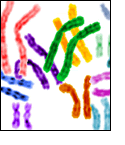|
 Previous Event | Next Event Previous Event | Next Event 
2004: Refined Analysis of Complete Human Genome Sequence

The International Human Gene Sequencing Consortium led in the United States by the National Human Genome Research Institute and the Department of Energy published a description of the finished human gene sequence. The analysis reduced the estimated number of genes (which as recently as the mid-1990’s had been ~100,000) from 35,000 to only 20,000-25,000. The fact that the human genome has far fewer genes than was originally thought suggests that humans “get more” out of their genetic information than do other animals. For example, the average human gene is able to produce three different gene products.
The finished sequence contains 2.85 billion nucleotides interrupted by only 341 gaps. It covers 99 percent of the genome with an accuracy of 1 error per 100,000 bases. Researchers confirmed the existence of 19,599 protein-coding genes and identified 2,188 other DNA segments that are thought to be protein-coding genes. Although the genome sequence is described as “finished,” it isn’t perfect. The small gaps that remain cannot be sequenced by the industrial-scale methods used by the Human Genome Project. Filling in these gaps will have to await a series of small targeted efforts by researchers using other techniques and possibly new technologies. The finished genome sequence can be freely accessed through public databases and may be used by researchers without restrictions.
More Information
Reference:
The International Human Genome Sequencing Consortium. Finishing the eukaryotic sequence of the human genome. Nature, 431: 931-945. 2004. [PubMed]
 Previous Event | Next Event Previous Event | Next Event 
Last Reviewed: April 10, 2008
|

